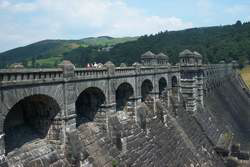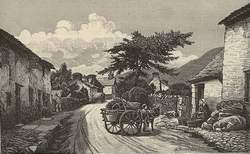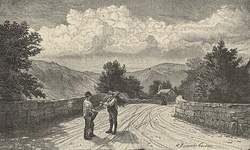Abandoned Communities ..... Reservoirs of Wales
It is difficult to study the reservoirs of Wales without becoming intrigued by the technology behind the storage and distribution of water. You are likely to learn about the functions of a straining tower and a submerged dam, and about the difference between a dam that carries the overflow over its crest and one that has a by-wash channel at one end. You will discover what diameter of piping is needed to carry a given volume of water, and what the minimum gradient must be in order to convey water by gravity alone. You will gain insight into the causes of water pollution and note the fact that grazing animals tend to generate surprisingly small quantities of pollution.
These, however, are not the topics of this section. Instead we will focus on those reservoirs whose construction meant the loss of a village or farming community. We will look at the distinctive culture of the communities that were submerged, review the interaction that transpired between the communities and the English urban corporations that had an urgent need for water, and consider the protests that were mounted against the planners of the reservoirs. Members of each community were usually too weak or too few in number to provide effective opposition, but in most cases they were joined by others who had an interest in preserving the threatened community. In particular we will see how Welsh nationalists came to take an increasing interest in such communities, and indeed used the events surrounding the acquisition of Welsh land for reservoirs to bolster their arguments in favour of Welsh self government.
All large towns and cities in Britain experienced an enormous increase in demand for water during the nineteenth century. The population of cities such as Liverpool and Birmingham was growing rapidly. The need for a clean water supply to counteract the diseases that spread easily in an urban environment was increasingly recognised. And of course it was a time of industrialisation, with most of the expanding industries making great use of water.
The first reservoir built in Wales by an English corporation was Lake Vyrnwy. Until the 1870s Liverpool had obtained its water from sources in Lancashire, but as demand continued to grow the corporation looked further afield. The Lake District of England was considered as well as North Wales, but in 1877 the water sub-committee of the corporation commissioned a full report on the potential of the Vyrnwy valley. Trial shafts were sunk to ensure that the bedrock would bear the weight of the dam, and then a parliamentary bill was prepared to gain authorisation for the construction of the dam, the aqueduct to Liverpool, and all associated works.
In order to create the reservoir Liverpool had to purchase about ten farms and the village of Llanwddyn. A place called Llanwddyn exists today, just below the dam. It comprises some of the houses into which residents of the original village were moved. The old village, however, lay at OS SH998213, a couple of hundred yards south of the point where the river Cedig now enters the lake. The village consisted of a church and two chapels, three pubs, at least two shops, one of which contained a post office, and about 37 houses.
The village of Llanwddyn can be seen on the Ordnance Survey map of 1887 at a scale of 1:2,500.
It appears that no formal consultation was carried out among the people of Llanwddyn, but the presence of engineers, surveyors and other visitors would have left them in no doubt about the intentions of the Liverpool corporation. A petition expressing opposition was organised. 331 signatures were collected, and the petition was submitted to the local member of parliament. In addition 31 objections to the bill were lodged in parliament by various organisations and landowners. These objections, however, were not on behalf of the people who would have to leave their homes, but related to the anticipated reduction in water flowing down the Vyrnwy and the Severn or to the effects of the construction of the aqueduct.
These, however, are not the topics of this section. Instead we will focus on those reservoirs whose construction meant the loss of a village or farming community. We will look at the distinctive culture of the communities that were submerged, review the interaction that transpired between the communities and the English urban corporations that had an urgent need for water, and consider the protests that were mounted against the planners of the reservoirs. Members of each community were usually too weak or too few in number to provide effective opposition, but in most cases they were joined by others who had an interest in preserving the threatened community. In particular we will see how Welsh nationalists came to take an increasing interest in such communities, and indeed used the events surrounding the acquisition of Welsh land for reservoirs to bolster their arguments in favour of Welsh self government.
All large towns and cities in Britain experienced an enormous increase in demand for water during the nineteenth century. The population of cities such as Liverpool and Birmingham was growing rapidly. The need for a clean water supply to counteract the diseases that spread easily in an urban environment was increasingly recognised. And of course it was a time of industrialisation, with most of the expanding industries making great use of water.
The first reservoir built in Wales by an English corporation was Lake Vyrnwy. Until the 1870s Liverpool had obtained its water from sources in Lancashire, but as demand continued to grow the corporation looked further afield. The Lake District of England was considered as well as North Wales, but in 1877 the water sub-
In order to create the reservoir Liverpool had to purchase about ten farms and the village of Llanwddyn. A place called Llanwddyn exists today, just below the dam. It comprises some of the houses into which residents of the original village were moved. The old village, however, lay at OS SH998213, a couple of hundred yards south of the point where the river Cedig now enters the lake. The village consisted of a church and two chapels, three pubs, at least two shops, one of which contained a post office, and about 37 houses.
It appears that no formal consultation was carried out among the people of Llanwddyn, but the presence of engineers, surveyors and other visitors would have left them in no doubt about the intentions of the Liverpool corporation. A petition expressing opposition was organised. 331 signatures were collected, and the petition was submitted to the local member of parliament. In addition 31 objections to the bill were lodged in parliament by various organisations and landowners. These objections, however, were not on behalf of the people who would have to leave their homes, but related to the anticipated reduction in water flowing down the Vyrnwy and the Severn or to the effects of the construction of the aqueduct.
One
Vyrnwy dam
The village of Llanwddyn
The bridge over the River Cedig, with the church in the distance


